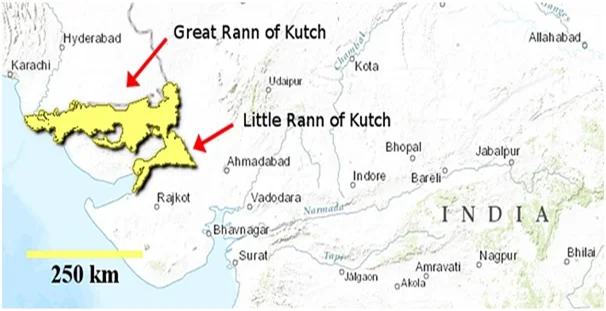Important Facts For Prelims
Saltpan Workers of Little Rann of Kutch
- 24 Jul 2023
- 4 min read
Why In News?
On July 18, 2023, saltpan workers (commonly known as agariyas) presented a representation to Gujarat Chief Minister and urged the state to intervene in response to instructions from forest department that restricted their entry into the Little Rann of Kutch.
What is the Order of the Forest Department?
- Little Rann of Kutch declared a wild ass sanctuary in 1972.
- Settlement survey conducted in 1997, permitting salt cultivation and leasing land to saltpan workers. Traditional agariyas were excluded from the benefits of the settlement survey.
- Legal Implications:
- Ongoing scrutiny of the 1997 settlement survey is being done by Gujarat High Court and National Green Tribunal involved in the resolution of land-poaching activities.
What are the Arguments Raised by Agariyas in Their Defence?
- Wild Ass Population Growth vs. Man-Animal Conflict: Census data shows a significant rise in the wild ass population in the area from 700 in 1973 to 6,082 in 2019.
- Census data ruled out the possibility of man-animal conflict in the Wild Ass Sanctury due to work of Saltpan workers.
- Saltpan Workers' Land Use: Saltpan workers use only 6% of the total land area for salt cultivation in Little Rann of Kutch, which is negligible in both quantity and space.
- Concerns against improper Survey: In meetings held at 16 out of 100-125 villages, forest department officials removed the names of 95% of the 8000 families of agariyas (saltpan workers).
- Most of the agariyas listed in the settlement survey report are not alive.
Who are the Saltpan workers?
- Koli, Sandhi, and Miyana communities residing in 100-125 villages around the Little Rann of Kutch in North Gujarat, Kutch, and Saurashtra regions are dependent on salt cultivation in the area called Saltpan workers.
- They are engaged in the profession for 600-700 years, dating back to the British rule.
About Wild Ass Sanctuary:
- Location: It is in the Little Rann of Kutch of the Gujarat State in India.
- It is the only place where the Indian wild ass, locally called Khacchar, is found.
- The sanctuary is home to a sizeable population of Rabari and Bhar wad tribes.
Key Facts about Indian Wild Ass:
- It is a sub-species of Asian Wild Ass, i.e., Equus hemionus.
- It is characterized by distinctive white markings on the anterior part of the rump and on the posterior part of the shoulder and a stripe down the back that is bordered by white.
- Distribution: World’s last population of Indian Wild Ass is restricted to Rann of Kachchh, Gujarat.
- Habitat: Desert and grassland ecosystems.
- Conservation Status:
- IUCN: Near threatened.
- CITES: Appendix II
- Wildlife Protection Act (1972): Schedule-I
UPSC Civil Services Exam, Previous Year Questions (PYQ)
Q. Among the following, who is the Agaria Community? (2009)
(a) A traditional toddy tappers community of Andhra Pradesh
(b) A traditional fishing community of Maharashtra
(c) A traditional silk-weaving community of Karnataka
(d) A traditional salt pan workers community of Gujarat
Answer: (d)






